White Dominicans
White Dominicans (Spanish: "Blanco", colloquially "Rubio") are Dominicans of complete or predominant European descent. They represent 16.1% of the Dominican Republic's population,[2] according to the last population census in which race was queried.[3] The majority of white Dominicans are descendants from the first European settlers to arrive in Hispaniola and have ancestry of the Spanish and French who settled in the island during colonial times, as well as the Canary Islanders, Portuguese who settled in the 17th and 18th centuries. Many others also descend from white Levantines,[4] Italians,[5][6] Dutchmen,[5][6] Germans,[5] Hungarians, Americans,[5][6] and other nationalities who have migrated between the 19th and 20th centuries.[5][6]
| Total population | |
|---|---|
| 1,100,000 (2006 survey) 13.6% of the Dominican population[1] 490,000 (1960 census) 16.1% of the Dominican population[2] | |
| Regions with significant populations | |
| Chiefly in Espaillat, Santiago, Santiago Rodríguez, and Valverde; also in Distrito Nacional, Hermanas Mirabal, La Vega, and Monte Christi. | |
| Santiago Rodríguez | 67%[2] |
| Valverde | 61%[2] |
| Languages | |
| Dominican Spanish | |
| Religion | |
| Predominantly Roman Catholicism, minority Protestantism | |
| Related ethnic groups | |
| Dominican people, Jewish Dominicans, White Latin Americans, White Cubans, White Puerto Ricans, White Haitians, White Hispanic and Latino Americans, Dominican Americans | |
White Dominicans historically made up a larger percentage in the Captaincy General of Santo Domingo, and for a time were the single largest ethnic group prior to the 19th century.[7][8] Currently whites make up a significant minority in the country, but it is not possible to quantify their numbers because the National Institute of Statistics (INE) does not collect racial data because of the race taboo that originated after Rafael Trujillo’s dictatorship;[3] although the Central Electoral Board still collected racial data until 2014.[9] According to a 2011 survey by Latinobarómetro, 11% of the Dominicans surveyed identified themselves as white.[10]
Population
The 1750 estimates show that there were 30,863 whites out of a total population of 70,625 in the colony of Santo Domingo.[7] The 1920 Santo Domingo Census was the first national enumeration. This revealed a total of 223,144 (24.9%) identifying as white. The second census, taken in 1935, covered race, religion, literacy, nationality, labor force and urban-rural residence.[11] Table shows the results per census to 1960 and a 2006 survey.
| European / white population per estimate and census 1750-1960 | ||||
|---|---|---|---|---|
| Year | Population | % of Dominican Republic | Total | Ref(s) |
| 1750 | 30,863 | 43.7 | 70,625 | [7][12] |
| 1790 | 40,000 | 32.0 | 125,000 | [13][14] |
| 1846 | 80,000 | 48.5 | [15] | |
| 1920 | 223,144 | 24.9 | 894,665 | [16] |
| 1935 | 192,732 | 13.0 | 1,479,417 | [17][18] |
| 1950 | 600,994 | 28.14 | 2,135,872 | [16] |
| 1960 | 489,580 | 16.1 | 3,047,070 | [2][19] |
| 2006 | 1.1 Million | 13.6 | [20] | |
The census bureau decided to discontinue its use of racial classifications in the 1970 census.[21] The Dominican identity card (issued by the Junta Central Electoral) used to categorised people as yellow, white, Indian, and black,[22] in 2011 the Junta planned to replace Indian with mulatto in a new ID card with biometric data that was under development, but in 2014 when it released the new ID card, it decided to just drop racial categorisation, the old ID card expired on 10 January 2015.[9][23] The Ministry of Public Works and Communications uses racial classification in the driver’s license, being white, mestizo, mulatto, black, and yellow the categories used. it was also applied to the Middle Eastern immigrants of the early 20th century.
History

Conquest and settlement
The presence of whites in the Dominican Republic dates back to the founding of La Isabela, one of the first European settlements in the Americas, by Bartholomew Columbus in 1493. The presence of precious metals such as gold boosted migration of thousands of Spaniards to Hispaniola seeking easy wealth. They tried to enslave the Taíno, but many of these died of diseases, and those who survived did not make good slaves.
In 1510, there were 10,000 Spaniards in the colony of Santo Domingo, and it rose to over 20,000 in 1520. But following the depleting of the gold mines, the island began to depopulate, as most poor Spanish colonists embarked to the newly conquered Mexico or to Venezuela (which was aggravated by the conquest of Peru in 1533).[24] This was followed by a limited Spanish migration toward Hispaniola, composed overwhelmingly by males. In order to counteract the depopulation and impoverishment of the colony, the Spanish Monarchy allowed the importation of African slaves to hew sugar cane.
By 1542 there were only few hundred natives. Several epidemics wiped out the remaining natives on the island.
The shortage of Spanish females led to miscegenation, that drove the creation of a caste system, (casta), in which white Spaniards were at the top, mixed-race people at middle, and Amerindians and black people at the bottom. Endogamy became a norm within the higher classes, in order to maintain their status and remain racially pure especially, specially because only pure whites were able to inherit majorats. As a result, Santo Domingo, like the rest of Hispanic America, became a pigmentocracy. The local-born whites were known as blancos de la tierra ("whites from the land"), in contrast to the blancos de Castilla, "whites from Castile".
The color prejudice between blacks and whites practically disappeared due to the great misery that prevailed in the colony.[25]
By the mid-17th century, the overall population decreased to 3,000 inhabitants and it was concentrated in or near the city of Santo Domingo.[26] About one tenth of the colony’s population was Portuguese-born; they were concentrated in the Cibao valley, where they had an influence on the Spanish dialect spoken in that area;[27] another 3% was born in Spain or descended exclusively from Spaniards.
18th century
During the eighteenth century, there were French colonists that settled in many Spanish towns, particularly in Santiago, by 1730 they totalled 25% of the population.[28] This was seen as a problem for the Spanish authorities, because if the population became mostly French, there could be problems of loyalty toward Spain.[29]
In 1718 a Royal Decree ordered the expel of the French people from Santo Domingo. The Grand Mayor of Santiago, Antonio Pichardo Vinuesta, refused to obey the decree arguing that most of the Frenchmen had married local women and that their expulsion would damage the economy of the Cibao. Grand Mayor Pichardo was tried and imprisoned in the city of Santo Domingo, but in the next year, the Council of the Indies reasoned in favor of Pichardo and decided a pardon to the French. In 1720-1721, a revolt in Santiago against a new tax on beef exports to the Saint Domingue, arose Frenchification fears in the Santo Domingo elite; Captain-General Fernando Constanzo, governor of the Santo Domingo, accused the Cibaenian elite of seeking to annex their province to France.[30]
After the failed plans of the Spanish Monarchy to expel the French colonists, the Monarchy decided to actively encourage the mass settlement of Spanish families in order to counteract the Frenchification of the colony.[29] Over the next decades, the Spanish colony of Santo Domingo was the subject of a mass migration of Spaniards, most of whom came from the Canary Islands.[31]
During that period, Neyba (1733), San Juan de la Maguana (1733), Puerto Plata (1736), Dajabón (1743), Montecristi (1751), Santa Bárbara de Xamaná (1756), San Rafael de la Angostura (1761), Sabana de la Mar (1761), Las Caobas (1763), Baní (1764), Las Matas de Farfán (1767), San Miguel de la Atalaya (1768), Moca (1773), Juana Núñez (1775), San José de los Llanos (1779), San Pedro de Macorís (1779), and San Carlos de Tenerife (1785), were founded.[31] Due to this migration, it decreased the amount of coloreds and blacks: the black population dropped to 12%, the mulatto population to 8%, and the quadroons to 31%.[15]
After that peak, the local white population began to migrate (especially towards Puerto Rico, Curaçao and Venezuela), first with the Haitian rule, and later with the constant political and economic instability after Dominican independence. Historically, migration to Puerto Rico was constant (except between 1898 and the 1930s, when there was a wave of Puerto Rican migrants to the Dominican Republic) and it boosted in the 20th century because of the oppressive regimes of Trujillo and Balaguer.[32] Although, the country has received a tiny but steady immigration (from other countries than Haiti), which has partly offset the constant emigration.
Saint-Domingue and the French acquisition of Santo Domingo
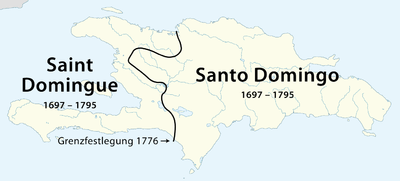
In the early seventeenth century, the Spanish government ordered the evacuation of the northern and western coast of the island, forcing relocation to areas close to the city of Santo Domingo as a defence measure against pirates from other European nations. This ended up being counterproductive to Spain, because in 1625 the pirates and buccaneers began to establish settlements on the island of Tortuga and in a strip north of Hispaniola surrounding Port-de-Paix. France dominated the buccaneers in the late 16th century and initiated the establishment of a colony that would enrich fast and rapidly expand throughout the western coast of Hispaniola. In 1777 France and Spain signed a border treaty, in which the western and northwestern coast of Hispaniola would be French and the rest of the island would be Spanish. By 1780 Saint-Domingue was the richest colony in the world, even than all the British Thirteen Colonies and the West Indies together. The French established an economy based on the production and export of sugar sustained on the forced labor of black slaves imported from west and central Africa. Slavery of blacks was characterized as one of the most ruthless in which terror and severe punishments were applied to slaves.[33]
By 1789, the population was composed as follows:[34][35][36]
- 40,000 Grand-blancs (literally "Great whites" in French) and Petit-blancs ("Little whites")
- 28,000 Sang-melés (French for: "Mixed blood") or free people of color.
- 452,000 slaves
The white population were 8% of Saint-Domingue’s population, but they owned 70% of the wealth and 75% of the slaves in the colony. The mulatto population were 5% of the population and had the 30% of the wealth. The slaves were 87% of the population.[36]
Haitian Revolution
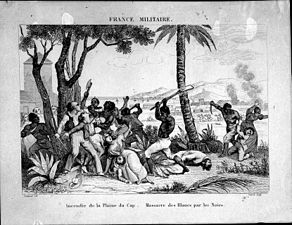
When the French Revolution started, the ideas of freedom among men spread in Saint-Domingue. Blacks (the majority of them were born in Africa, such as Jean-Jacques Dessalines) rebelled against their white masters and began a genocide against the French. In 1791, more than a thousand were killed.[36] In order to preserve their lives, they fled Saint-Domingue. The wealthy grand-blancs, returned to France or went to French Louisiana, but the petit-blancs who did not have many resources were compelled to move to the Eastern side of Hispaniola; although many of them went to Cuba,[37] and to Venezuela as well.
Notably, there were many sang-melés, some of which fled from Saint-Domingue as well, and settled in neighboring islands, mostly Puerto Rico and Cuba.
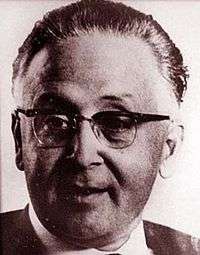
This French Creole (Franco-Haitian) migration toward the current Dominican Republic brought to the country many surnames like Beltrand (and its variants Beltrán and Beltré), Bisonó, Beauregard, Candelier, Ciprián, Coradín, Dipré (originally Dupré), Ferrant, Gautreaux, LaChapelle, Lavandier, Leclerc, Marichal, Morel, Oliver, Poueriet, Saint-Hilaire, and Yaclamic.[40][41][42][43]
The Treaty of Basel, signed in 1795, in which Spain ceded the eastern two-thirds of the island of Hispaniola to France in exchange for keeping Gipuzkoa, was supposed to be put into effect immediately, but the French authorities didn't comply in lieu that they were focused on the disturbances taking place in Saint-Domingue as well as the uprising of a revolution in France. It wasn't until 1801 when the black freedman Gen. Toussaint Louverture decided to invade Santo Domingo with his army under the guise proclaiming the abolition of slavery on behalf of the French Republic and then captured Santo Domingo from the French and took control of the entire island. From 1795 to 1801 the Dominicans were still ruled by the Brig. Joaquín García y Moreno, and Toussaint Louverture was governor from 1801-1802.
Haitian rule
The Unification of Hispaniola lasted from 1822 until 1844, and sometime during this span, a totalitarian military government took place that forbade the Dominican people by law from taking public office, were on permanent curfew since early dusk and had the public university closed down on the pretext that it was a subversive institution.
Emigration
Due to political instability during the España Boba period, some of the whites in Santo Domingo fled the country between 1795 and 1820, mainly to Venezuela, Puerto Rico, and Cuba. However, many white families stayed on the island. Many whites in Santo Domingo did not consider owning slaves due to the economic crisis in Santo Domingo. But the few rich white elites that did, fled the colony. Many of these white families that stayed on the island settled in the cibao region owning land. Some Dominican historians and intellectuals, such as Américo Lugo, Joaquín Balaguer and Antonio del Monte y Tejada, deplored that "Santo Domingo lost most of its best families" at that era, specially during the Haitian domination.[3][44][45] After independence and being under Spanish control again in 1863, many families returned to the island including new waves of immigration from Spain occurred.
Post-independence immigration
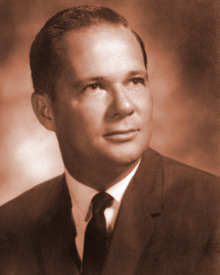
The majority of the immigrants that settled in the Dominican Republic in the 19th century and the first half of the 20th century established their residence in Santo Domingo, Santiago, Moca and Puerto Plata.
During the 19th century Puerto Plata was the most important port in the country (and even became provisional capital) and hosted the European and North American migration to the Dominican Republic. The majority were Germans traders and tobacco producers, most of these German were from Hamburg and Bremen. There were also Englishmen, Dutch, Spaniards (mainly from Catalonia), Cubans (at least 4,000 immigrated during the Ten Years' War) and Italians. After the Restoration War there was an inflow of U.S. and French. The most prominent migrants’ surnames that went to this city were Arzeno, Balaguer, Batlle, Bonarelli, Brugal, Capriles, Demorizi, Ferrari, Imbert, Lithgow, Lockward, McKinney, Paiewonsky, Prud’homme, Puig, Rainiere, Villanueva, Vinelli and Zeller. In 1871, half of Puerto Plata’s population was foreigner; and in both the 1888 and 1897 censuses, 30% was of foreign born.[5][6]
Most of the offspring of Puerto Plata’s immigrants moved to Santiago and Santo Domingo in the 20th century.
Lebanese immigration
It is estimated that 80,000 Dominicans are descendants of Lebanese migrants. The Bourdier family are French & Lebanese. As well as Nadar family.[4]
In the mid-1880s the early immigrants arrived to the Dominican Republic, mainly to Puerto Plata and Santo Domingo, and after 1897 to Santiago. At first, they were despised by many (especially by merchants and peddlers who saw them as competitors, and later the aristocratic classes that prevented their entry into social clubs), but over the course of 50 years, they achieved a solid economic status and a prominent place within Dominican society. After 1900 many settled in San Pedro de Macorís, a city that lived through this migration an economic and cultural boom, that made San Pedro de Macoris to be known as the 'Sultana of the East'.[46]
Geographic distribution
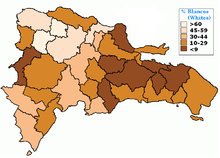
The core area of white Dominicans or European descendent population is the Cibao or Northern region, particularly the Sierra[lower-alpha 1] where according to the 1950 census, six out of ten people are white.[47] The Southeastern and Southwestern regions have fairly smaller concentrations of whites in comparison to the North with the exception of the city of Santo Domingo.[48][49]
The Sierra was peopled in the 18th century mostly by ethnic Canarians and French who established a markedly endogamous society in which cousin marriages were fairly common, in order to preserve their whiteness; African slaves were negligible except in San José de las Matas, where today there is a large admixed population. The Sierra received a sizeable amount of white and mulatto refugees from both Saint-Domingue and the Cibao Valley, the former during the Haitian Revolution and the latter amid the Dominican genocide by the Haitian army in 1805.[50][51]
Whiteness and social status
.jpg)
The Dominican Republic is not different to other countries that were colonized by Europeans, and shows a clear correlation between race and wealth. The upper and upper-middle classes of the Dominican Republic are overwhelmingly of European origin.[52][53]
The middle class, which is the class with the broadest colour spectrum,[54] is roughly ⅓ white. Altogether, about 45% of the lower-middle, upper-middle and upper class Dominicans are white, with mixed-race Dominicans reaching a similar proportion.[53]
The lower class is overwhelmingly of mixed-race (81%).[53]
Establishment of a European elite
Limpieza de sangre (Spanish: [limˈpjeθa ðe ˈsaŋɡɾe], meaning literally "cleanliness of blood") was very important in Mediæval Spain,[55] and this system was replicated on the New World. The highest social class was the Visigothic nobility of Central European origin,[56] commonly known as people of "sangre azul" (Spanish for: "blue blood"), because their skin was so pale that their veins looked blue through it, in comparison with that of a commoner who had olive skin. Those who proved that they were descendants of Visigoths were allowed to use the style of Don and were considered hidalgos. Hidalgos nobles were the most benefited of those Spanish who emigrated to America because they received royal properties (such as cattle, lands, and slaves) and tax exemptions. These people achieved a privileged position, and most of them avoided mixing with natives or Africans. This led to certain family names to be related both to whiteness, as with a better social-economic position; these family names were Angulo, Aybar, Bardecí, Bastidas, Benavides, Caballero, Cabral, Camarena, Campusano, Caro, Coca, Coronado, Dávila, De Castro, De la Concha, De la Rocha, Del Monte, Fernández de Castro, Fernández de Fuenmayor, Fernández de Oviedo, Frómesta, Garay, Guzmán, Heredia, Jiménez (and its variant Jimenes), Jover, Landeche, Lora, Leoz y Echálaz, Maldonado, Mieses, Monasterios, Mosquera, Nieto, Ovalle, Palomares, Paredes, Pérez, Pimentel, Quesada, Serrano, Solano, Vega, and Villoria.[57]
The Spanish of the highest rank who migrated to America in the sixteenth century was the noblewoman Doña María Álvarez de Toledo y Rojas, granddaughter of the 1st Duke of Alba, niece of the 2nd Duke of Alba, and grandniece of King Ferdinand of Aragon; she was married to Diego Columbus, Admiral and Viceroy of the Indies.[57]
Many Criollo families migrated to other Spanish colonies.
Further immigration from the 17th and 18th centuries made subsequently that newly rich families emerged among them, which are: Alfau,[58] De Marchena, Mirabal, Tavárez (and its variants Tavares and Taveras), Lopez-Penha, Marten-Ellis and Troncoso.
And others from the 19th and 20th centuries: Armenteros, Arzeno,[6][59] Báez, Barceló, Beras, Bermúdez, Bonetti, Brugal, Corripio, Esteva, Goico, Haché,Hoffiz, Lama, León, Morel, Munné, Ottenwalder, Pellerano,[60] Paiewonski, Piantini, Rochet, Rizek, Vicini, Vila,[61] and Vitienes.
See also
Notes
- The Cibao Sierra or La Sierra is a geographic and ethnocultural area composed by the province of Santiago Rodríguez and the highlands of the Santiago province: the municipalities of Jánico, Sabana Iglesia, and San José de las Matas (Sajoma).
References
- "La variable étnico racial en los censos de población en la República Dominicana" [The ethnic-racial variables in the population censuses in the Dominican Republic] (in Spanish). Dominican Republic Office for National Statistics. July 2012. Archived from the original (PDF) on 29 July 2013.
- Cuarto censo nacional de población, 1960. Oficina Nacional del Censo. 1966. p. 32.
- Frank Moya Pons (2010). Historia de la República Dominicana (in Spanish). 2. Santo Domingo: CSIC. pp. 50–51. Retrieved 23 May 2013.
- González Hernández, Julio Amable (11 August 2012). "Registro de Inmigrantes de El Líbano". Cápsulas Genealógicas en Areíto (in Spanish). Santo Domingo: Instituto Dominicano de Genealogía. Retrieved 28 May 2013.
(...) Se calcula que en República Dominicana existen unos 80,000 descendientes de esos inmigrantes que una vez dejaron sus tierras para buscar una vida mejor.
- Zeller, Neicy Milagros (1977). "Puerto Plata en el siglo XIX". Estudios Dominicanos (in Spanish). eme eme. Retrieved 21 June 2013.
- Ventura Almonte, Juan. "Presencia de ciudadanos ilustres en Puerto Plata en el siglo XIX" (PDF) (in Spanish). Academia Dominicana de la Historia. Archived from the original (PDF) on 13 June 2013. Retrieved 21 June 2013.
- R. Haines, Michael; H. Steckel, Richard. "A Population History of North America". Retrieved 10 August 2020.
- Stanley J. Engerman, Barry W. Higman, "The demographic structures of the Caribbean Slaves Societies in the Eighteenth and Nineteenth Centuries", General History of the Caribbean: The Slave Societies of the Caribbean, vol. III, London, 1997, pp. 48–49.
PUERTO RICO: 17,572 whites; 5,037 slaves; 22,274 freed coloured people; total- 44,883. CUBA: 116,947 whites; 28,760 slaves; 24,293 freed coloured people; total- 170,000. SANTO DOMINGO: 30,863 whites; 8,900 slaves; 30,862 freed coloured people; total- 70,625. TOTAL SPANISH COLONIES: 165,382 whites; 42,967 slaves; 77,429 freed coloured people; total- 285,508.
- Néstor Medrano; Ramón Pérez Reyes (23 April 2014). "La JCE acelera cedulación en instituciones del país" (in Spanish). Listín Diario. Retrieved 9 April 2015.
Entre las novedades del nuevo documento no se establece como se hacía anteriormente el color de la piel de la persona, ya que, la misma fotografía consigna ese elemento.
- Informe Latinobarómetro 2011, page 58
- "Dominican Republic, Summary of Biostatistics: Maps and Charts, Population". United States. Bureau of the Census. Retrieved 10 August 2020.
- Stanley J. Engerman, Barry W. Higman, "The demographic structures of the Caribbean Slaves Societies in the Eighteenth and Nineteenth Centuries", General History of the Caribbean: The Slave Societies of the Caribbean, vol. III, London, 1997, pp. 48–49.
PUERTO RICO: 17,572 whites; 5,037 slaves; 22,274 freed coloured people; total- 44,883. CUBA: 116,947 whites; 28,760 slaves; 24,293 freed coloured people; total- 170,000. SANTO DOMINGO: 30,863 whites; 8,900 slaves; 30,862 freed coloured people; total- 70,625. TOTAL SPANISH COLONIES: 165,382 whites; 42,967 slaves; 77,429 freed coloured people; total- 285,508.
- Dominican Republic Foreign Policy and Government Guide Volume 1 Strategic By IBP, Inc.
- Helen Chapin Metz, ed. (December 1999). "The first colony". Dominican Republic : country studies. Washington, DC: Federal Research Division, Library of Congress. ISBN 0844410446. Retrieved 3 August 2013. Lay summary.
As a result of the stimulus provided by the trade reforms, the population of the colony of Santo Domingo increased from about 6,000 in 1737 to approximately 125,000 in 1790. Of this number, about 40,000 were white landowners, about 25,000 were black or mulatto freedmen, and some 60,000 were slaves. The composition of Santo Domingo's population contrasted sharply with that of the neighboring French colony of Saint-Domingue, where some 30,000 whites and 27,000 freedmen extracted labor from at least 500,000 black slaves. To the Spanish colonists, Saint- Domingue represented a powder keg, the eventual explosion of which would echo throughout the island.
- Franco Pichardo, Franklin J. (2009). Historia del Pueblo Dominicano (in Spanish). Santo Domingo: Ediciones Taller. p. 217.
- Frank Moya Pons (1999). Breve Historia Contemporánea de la República Dominicana (in Spanish). Fondo De Cultura Economica USA. p. 62.
Según los datos del primer censo nacional, la población dominicana estaba compuesta por un 24.9% de blancos, (...) en 1920 había 223 144 blancos (...)
- Dominican Republic, Summary of Biostatistics: Maps and Charts, Population ...(Page 41).
- Historia de la República Dominicana, Volume 2 By Frank Moya Pons
- Power and Television in Latin America: The Dominican Case By Antonio V. Menéndez Alarcó
- "La variable étnico racial en los censos de población en la República Dominicana (Encuesta Latin American Public Opinion Project 2006)". 2006. Retrieved 10 August 2020.
- Moya Pons, Frank (2010). Historia de la República Dominicana (in Spanish). 2. Madrid: CSIC. pp. 50–52. ISBN 978-84-9744-106-3. Retrieved 8 November 2014.
- De León, Viviano (11 November 2011). "RD será de negros, blancos y mulatos : Reforma electoral eliminaría el color indio". Listín Diario (in Spanish). Retrieved 25 October 2014.
- Néstor Medrano (10 January 2015). "La cédula vieja vence hoy; miles acuden a centros JCE" (in Spanish). Listín Diario. Retrieved 9 April 2015.
- Bosch, Juan (1995). Composición Social Dominicana (PDF) (in Spanish) (18 ed.). Santo Domingo: Alfa y Omega. p. 45. ISBN 9789945406108. Retrieved 3 September 2014.
"Aunque, siguiendo a Herrera, Sánchez Valverde diga que después de lo que escribió Oviedo aumentó el número de ingenios, parece que el punto más alto de la expansión de la industria azucarera se consiguió precisamente cuando Oviedo escribía sobre ella en 1547. Ya entonces había comenzado el abandono de la isla por parte de sus pobladores, que se iban hacia México y Perú en busca de una riqueza que no hallaban en la Española".
- Moreau de Saint-Méry, Médéric Louis Élie. Description topographique et politique de la partie espagnole de l'isle Saint-Domingue. Philadelphia. pp. 55–59.
- Frank Moya Pons (2004). "Memoria de la diversidad colectiva". Desde la Orilla: hacia una nacionalidad sin desalojos (in Spanish). Santo Domingo. p. 49. ISBN 99934-960-9-X.
- Sención Villalona, Augusto (2010). Haché, Juana (ed.). Historia dominicana: desde los aborígenes hasta la Guerra de Abril (in Spanish) (AGN-118 ed.). Santo Domingo: Editora Alfa y Omega. pp. 4–5. ISBN 978-9945-074-10-9.
- Gutiérrez Escudero, Antonio (1985). Población y Economía en Santo Domingo, 1700-1746 (in Spanish). Seville, Spain.
- Gutiérrez Escudero, Antonio (2005). Élites y poder económico en Santo Domingo (siglo XVIII) (in Spanish). ISBN 84-472-0874-5.
- Hernández González, Manuel (2006). Expansión fundacional y crecimiento en el norte dominicano (1680-1795): El Cibao y la Bahía de Samaná (in Spanish). Santa Cruz de Tenerife: Ediciones Idea. pp. 104–119. ISBN 84-96640-60-4.
- Emilio Cordero Michel; Roberto Cassá. "La Huella Hispánica en la Sociedad Dominicana" [The Spanish trace in the Dominican Society]. 2013 (in Spanish). Historia Dominicana (The authors belong to the Dominican Academy of History). Archived from the original on 2013-06-24. Retrieved 9 February 2017.
- Margarita Estrada, Pascal Labazée, ed. (2007). "La migración dominicana hacia Puerto Rico: una perspectiva transnacional". Globalización y localidad: espacios, actores, movilidades e identidades (in Spanish). Mexico City: La Casa Chata. p. 400. ISBN 978-968-496-595-9. Retrieved 28 May 2013.
(...) Los historiadores han documentado la creciente presencia puertorriqueña en la República Dominicana durante el primer tercio del siglo XX. En 1920, el censo dominicano contó 6069 puertorriqueños residentes en la República Dominicana. Como resultado, los inmigrantes de segunda generación generalmente se identificaron como dominicanos, no como puertorriqueños. Los casos más célebres son los expresidentes Joaquín Balaguer y Juan Bosch, ambos de ascendencia dominicana y puertorriqueña. La madre de Pedro Mir, uno de los poetas contemporáneos más distinguidos de la República Dominicana, era puertorriqueña. El prominente escritor puertorriqueño, José Luis González, nació en Santo Domingo de padres puertorriqueños, pero se mudó a San Juan de niño.
- Robert Heinl, Written in Blood: The History of the Haitian People (University Press of America: Lantham, Md., 1996)
- Leyburn, James. El pueblo haitiano.
- James, C.L.R. "The Black Jacobins". p. 55.
- Dr. Mu-Kien Adriana Sang (1999). Dr. Mu-Kien Adriana Sang (ed.). Historia Dominicana: Ayer y Hoy (in Spanish). SUSAETA Ediciones Dominicanas. pp. 78–79, 81.
- William R. Lux (1972). "French Colonization in Cuba, 1791-1809" (PDF). The Americas. Cambridge University Press. 29 (1). doi:10.2307/980536. Retrieved 10 March 2016.
- Ivonna Ginebra (1995). "Segundo Encuentro de la Familia Bonnelly" (PDF). Instituto Dominicano de Genealogía. Archived from the original (PDF) on 24 April 2014. Retrieved 24 April 2014.
- Edwin Rafael Espinal Hernández (9 April 2005). "Precisiones sobre el origen de la familia Fondeur" (in Spanish). Instituto Dominicano de Genealogía. Archived from the original on 18 January 2015. Retrieved 9 May 2014.
- "Encuentre al haitiano detrás de su apellido "dominicano" consultando esta lista" [Find the Haitian behind your "Dominican" surname at this list]. 7días (in Spanish). 28 September 2013. Archived from the original on 7 December 2013. Retrieved 7 December 2013.
- Aurich Martínez, Jail Lenín (22 September 2007). "Los Model de El Seibo (1 de 4)". Instituto Dominicano de Genealogía. Retrieved 23 May 2013.
Tras la firma del Tratado de Basilea en 1795, la Corona española cedió la parte Este de la isla La Española a Francia. Se iniciaría así una importante inmigración de colonos franceses, en toda la geografía de la antigua colonia española de Santo Domingo, siendo focos importantes de estos asentamientos los poblados de Higüey y El Seibo. En este último poblado se asentaron varios inmigrantes franceses. Uno de estos fue el galo Juan Morel Doñac, (...)
- Díaz Jáquez, Leonardo (February 2010). "Origen del Apellido Saint-Hilaire en Suelo Dominicano". Charlas Genealógicas (in Spanish). Instituto Dominicano de Genealogía. Retrieved 21 June 2013.
- Luciano, Lily (3 March 2009). "Apellidos franceses en la Península de Samaná". Hoy (in Spanish). Retrieved 5 December 2014.
- Thomas E. Weil (1973). Dominican Republic: A Country Study. Washington, DC: American University. pp. 37–38, 40, 51–52.
- Ernesto Sagás. "A Case of Mistaken Identity: Antihaitianismo in Dominican Culture". St. Louis, Missouri: Webster University.
- Inoa, Orlando. "4: La herencia árabe". In Torres-Saillant, Silvio; Hernández, Ramona; Jiménez, Blas R. (eds.). Desde la Orilla: hacia una nacionalidad sin desalojos (in Spanish). Illustrated by Silvestrina Rodríguez-Collado. Santo Domingo: Editora Manatí. pp. 87–106. ISBN 978-999-349-609-0. Retrieved 4 August 2014.
- Tercer censo nacional de población, 1950. Oficina Nacional del Censo. 1958. pp. 60–61.
- López Morillo, Adriano (1983). Memorias sobre la segunda reincorporación de Santo Domingo a España (in Spanish). Sociedad Dominicana de Bibliófilos. p. 69.
- Del Rosario Pérez, Ángel S. (1957). La exterminación añorada (in Spanish). p. 194.
- Espinal Hernández, Edwin R. (28 August 2010). "Población, endogamia y consanguinidad. Genealogía en la Sierra de San José de Las Matas" (in Spanish). Instituto Dominicano de Genealogía. Retrieved 16 May 2015.
- Hernández González, Manuel V. (2007). Expansión fundacional y crecimiento en el norte dominicano (1680-1795): El Cibao y la Bahía de Samaná (PDF) (in Spanish). Santo Domingo: Archivo General de la Nación; Academia Dominicana de la Historia. ISBN 978-9945-020-12-0. Archived from the original (PDF) on 25 May 2015. Retrieved 16 May 2015.
- Foley, Erin; Jermyn, Leslie (2005). Dominican Republic. Tarrytown, NY: Marshall Cavendish. pp. 60–61. ISBN 0-7614-1966-7. Retrieved 26 June 2015.
- Howard, David (2001). Coloring the Nation: Race and Ethnicity in the Dominican Republic. Oxford, United Kingdom: Signal Books. pp. 50, 69. ISBN 1-902669-11-8. Retrieved 26 June 2015.
- Bell, Ian (1981). The Dominican Republic. Westview Press. p. 121. ISBN 9780510390426. Retrieved 26 June 2015.
- "The Visigoths in Spain" (aspx). Spain Then and Now. Retrieved 14 June 2013.
- The Basque History Of The World.
- "Origen de la Genealogía Dominicana". Areíto (in Spanish). Hoy. Retrieved 4 May 2008.
- Instituto Dominicano de Genealogía (5 January 2013). "Familia Alfau" (PDF) (in Spanish). Hoy. p. 4. Retrieved 14 June 2013.
- "Una trayectoria de familia". Listín Diario (in Spanish). Santo Domingo. 26 May 2013. Retrieved 14 June 2013.
- "Los Pellerano".
- "Los distinguidos Vila". Hoy Digital (in Spanish).
.jpg)

